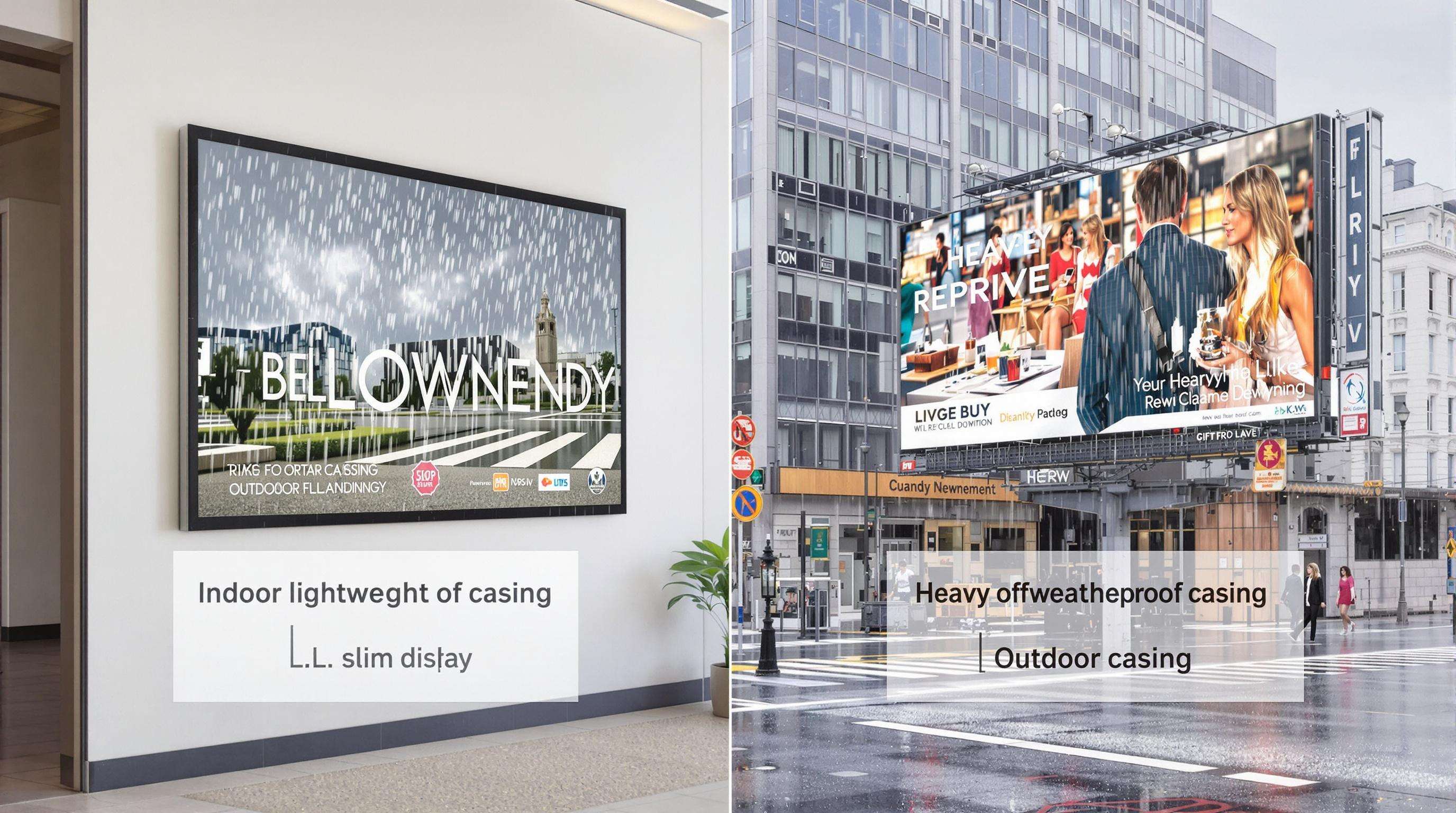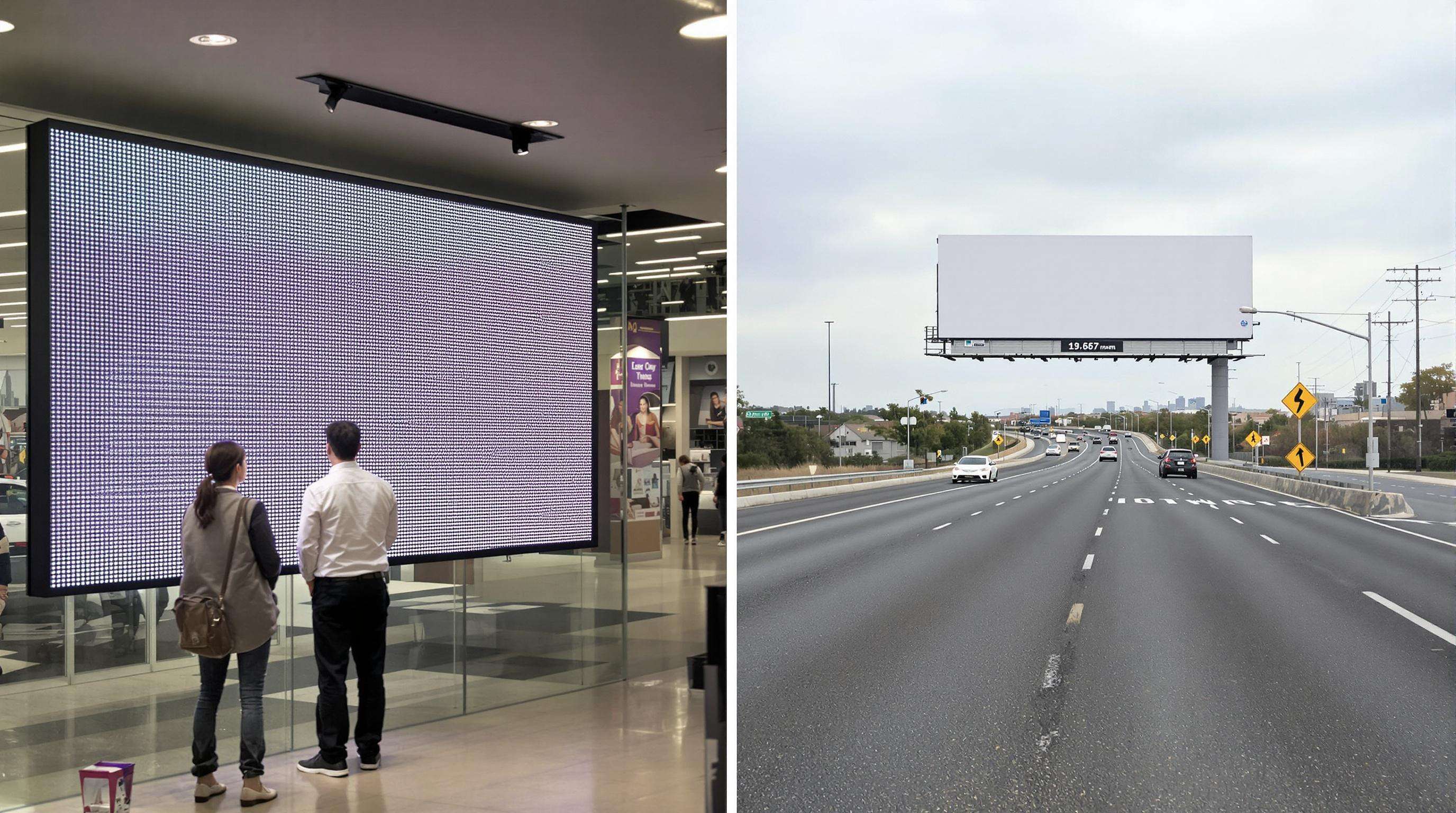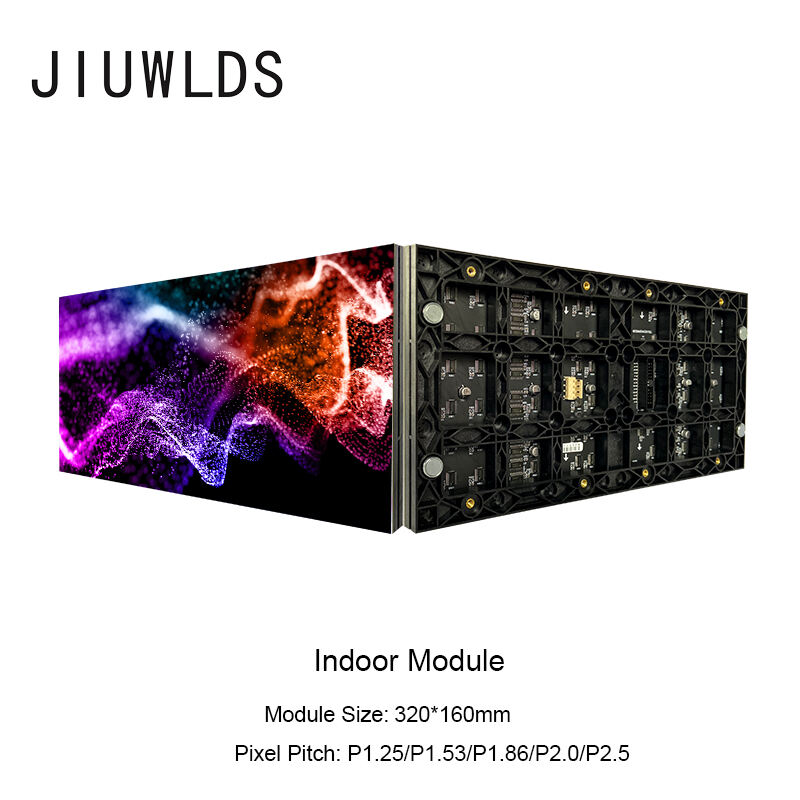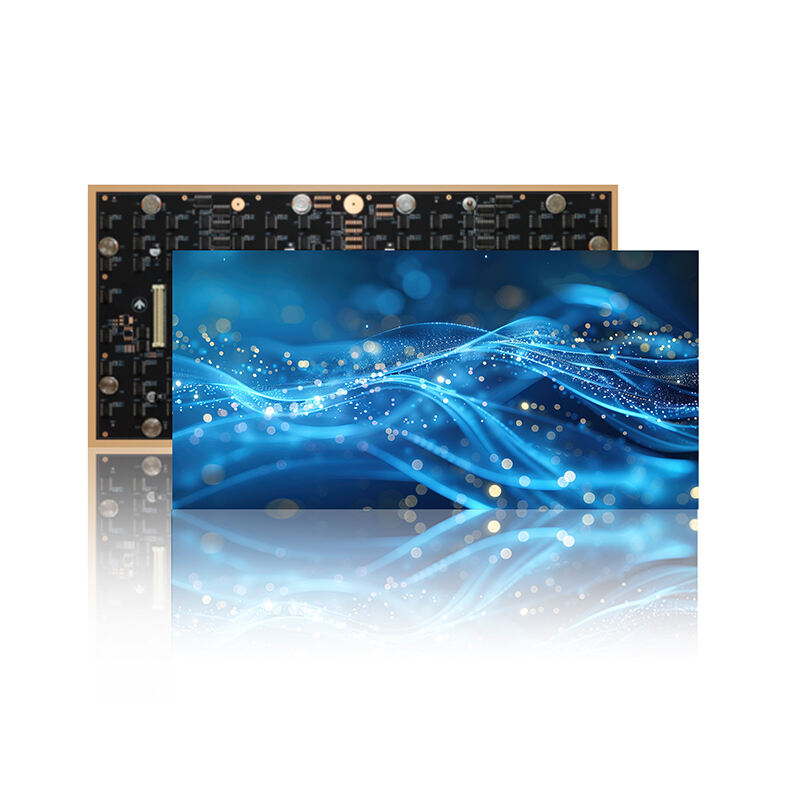Miten valita sisä- ja ulkokäyttöön tarkoitettujen LED-näyttöjen välillä?
Peruserot sisä- ja ulkokäyttöisten LED-näyttöjen välillä

Sisä- ja ulkokäyttöisten LED-näyttöjen rakenteelliset ja suunnitteluerot
Sisäkäyttöön tarkoitetut LED-näytöt ovat yleensä erittäin ohuita, ja niiden syvyys ei yleensä ylitä noin 100 mm:ää. Ne on valmistettu kevyistä muoviyhdistelmämateriaaleista. Näiden ominaisuuksien ansiosta ne soveltuvat erinomaisesti seinä- tai kattoasennukseen tiloissa, joissa on rajoitettu tila käytettävissä ja olosuhteet ovat vakaita. Ulkokäyttöön tarkoitetut versiot ovat kuitenkin toisenlaisia. Niissä on kestävät alumiinikehykset ja ne varustetaan suojakannoilla, joiden suojatason IP65 takia ne kestävät kaiken sään aiheuttamat vaikutukset, kuten voimakkaan sateen, pölymyrskyt ja lämpötilan vaihtelut, jotka vaihtelevat miinus 30 celsiusasteesta jopa kuumuuteen, joka on jopa 50 celsiusastetta. Lämpötilan säätelyssä ulkomallit vaativat lisäapua lämmön kerääntymisen torjumiseksi, minkä vuoksi useimmissa malleissa on aktiivinen jäähdytysjärjestelmä, kuten sisäänrakennettu tuuletin. Sisäyksiköissä tällainen jäähdytys ei ole välttämätöntä, koska niiden ohuempi rakenne mahdollistaa lämmön luonnollisen poistumisen kotelon erityisissä ilmanvaihtoaukkoissa.
Teknologia ja laitteiston yhteensopivuus ympäristön mukaan
Sisä-LED-näytöt käyttävät yleensä SMD-teknologiaa (Surface-Mounted Device), joka mahdollistaa korkean pikselitiheyden ja hienojakoisten näyttöjen (P2,5–P4) terävien kuvien tuottamisen lähietäisyydeltä katsottuna. Ulkonäytöt suosivat DIP-LED-teknologiaa (Dual In-Line Package), joilla saavutetaan korkeampi kirkkaus (5 000–8 000 nit) ja parempi kestävyys vaikeissa olosuhteissa. Keskeiset erot ovat seuraavat:
| Ominaisuus | Sisäänkäynti-led | Outdoor led |
|---|---|---|
| Kirkkausalue | 600–1 200 nit | 5 000–8 000 nit |
| Pikselien pitch | P2,5–P4 | P6–P20 |
| Toimintatemperatuuri | 0 °C–40 °C | -30 °C–50 °C |
Kuinka käyttöympäristö vaikuttaa näytön valintaan
Useimmat myymäläympäristöt valitsevat sisäkäyttöön tarkoitettuja LED-näyttöjä, koska ne tarjoavat erinomaisen värjitarkkuuden (ΔE alle 3) ja näyttävät hyviltä myös tavallisessa kaupan valaistuksessa (noin 300 luxia). Ulkotiloissa, kuten valtakunnallisilla moottoritiejulisteilla, asiat ovat toisin. Näissä tarvitaan erittäin kirkkaita näyttöjä, joiden kirkkaus voi olla jopa 8 000 kandelaa neliömetriä kohti, jotta ne näkyvät selvästi yli 150 metrin etäisyydeltä. Viime vuonna 2023 julkaistu raportti digitaalisesta mainonnasta paljasti myös mielenkiintoisen seikan: ulkokäyttöiset näytöt kuluttavat noin 35 % enemmän sähköä sen vuoksi, että niiden kirkkaus on paljon suurempi. Mutta siinä on kompensoivana tekijänä elinaika! Ulkokäyttöön tarkoitetut mallit kestävät yleensä 8–10 vuotta tiiviin rakenteen ja modulaarisen suunnittelun ansiosta, kun taas sisäkäyttöisten mallien elinkaari on yleensä vain 6–8 vuotta ennen kuin ne täytyy vaihtaa.
Kirkkaus, kontrasti ja näkyvyys eri valaistusolosuhteissa
Kirkkausvaatimukset sisä- ja ulkokäyttöön tarkoitettujen LED-näyttöjen välillä
Jotta ulko-LED-näytöt säilyvät luettavina kirkkaassa auringonvalossa, niiden kirkkauden tulisi yleensä olla noin 5 000–10 000 nit. Sisäkäyttöön tarkoitetut versiot toimivat hyvin selvästi pienemmällä kirkkaustasolla, tyypillisesti noin 300–800 nit valmistajien suositusten mukaan. Suuri ero johtuu siitä, että ulkokäytössä täytyy torjua kovaa auringonvaloa, kun taas sisätiloissa keskeistä on heijastusten hallinta ja sähkönsäästö. Useat uudet näytöt ovat nykyään varustettu sisäänrakennetuilla valonantureilla, jotka säätävät automaattisesti näytön kirkkautta päivän mittaan. Näillä älykkäillä järjestelmillä säästetään sähköä öisin heikentämättä näkyvyyttä päivällä.
Kontrasti ja sisällön näkyvyys ympäristövalossa
Kun on kyse näytöistä ulkona, niissä täytyy olla huomattavasti suurempi kontrastisuhde, noin 2000:1 tai parempi, pelkästään yhden tason yksityiskohtien säilyttämiseksi kun aurinko paistaa kirkkaana. Sisätiloihin tarkoitettuja näyttöjä käytetään yleensä noin 1000:1 kontrastisuhteella, koska se tuntuu mukavammalta ihmisille, jotka istuvat lähellä. Ulkona, jossa ei ole lainkaan varjoa, ympäröivä päivänvalo voi itse asiassa vähentää havaitsemaamme kontrastia noin puoleen, joskaan ei aina, mikä tarkoittaa sitä, että värjäystä täytyy nostaa melkoisesti. Useimmat ulkokilvet valitsevat tummien taustojen ja kirkkaiden valkoisten kirjainten yhdistelmän, koska se erottuu muusta ympäristöstä tehokkaasti. Sisätiloissa taas suunnittelijat tyypillisesti käyttävät tasapainoisempia värityskombinaatioita, jotka eivät rasita silmiä pitkien katsomisjaksojen aikana.
Katsoiskulmat ja ympäristön vaikutus kirkkaukseen
Ulkona sijaitsevat LED-näytöt tarjoavat yleensä huomattavasti laajemmat katselukulmat, noin 160 astetta tai enemmän, joten ne toimivat hyvin niin jalankulkijoiden kuin ajoneuvojen ohitse ajaessakin. Sisätiloihin asennettujen näyttöjen katselukulmat ovat yleensä noin 120 astetta, koska suurin osa katsojista pysyy paikallaan. Voimakkaassa sateessa ulkonäytöt muuttuvat hyvin sumuisiksi, ellei niissä ole erityistä veden hylkivää pinnoitetta. Sisäkäyttöön tarkoitetut näytöt vaativat ilman, jonka kosteus on riittävän kostea, mieluiten yli 30%:n ilmankosteus, muuten sisäosien vaurioitumisella voi olla pitkäaikaista vauriovaaraa. Vaihtelevien valaistusolosuhteiden hallintaan ulkona toimivat antiheikkaukselliset pinnoitteet ovat tehokkaampia kuin sisäkäyttöön tarkoitettu matte pinta. Tämä tekee eron, kun auringonvalo osuu näytölle eri aikoina päivästä tai varjot liikkuvat sen yli iltapäivällä.
Ympäristönkestävyys ja sääoloja kestävyys ulkokäyttöön
IP-luokitus ja sääsuojaus ulko-LED-näytöissä
Ulkoilmaled-näytöille on melko välttämätöntä saavuttaa vähintään IP65-luokitus, jos niiden tulee kestää pölyä ja ärsyttäviä matalapaineisia vesipisaroita, joita tulee esimerkiksi sadekuuroissa. Jotkin huipputason mallit menevät vielä pidemmälle ja niissä on IP67- tai IP68-sertifikaatit, mikä tarkoittaa käytännössä, että ne kestävät tilapäistä upottamista veteen ilman merkittäviä ongelmia. Mikä mahdollistaa tämän? Valmistajat rakentavat ne yleensä syvästi ruostumattomista alumiini- tai teräskoteloista, lisäksi niissä on silikonitiivisteitä ja erityisiä veden hylkiväksi tehtyjä pinnoitteita. Sisäkäyttöiset näytöt eivät tarvitse kaikkia näitä lisäsuojauksia, koska suurin osa sisätiloista säilyttää ilmaston tasaisena vuoden ympäri.
Sääolosuhteiden vaikutus näyttöjen suorituskykyyn
Kun lämpötila laskee alle 14 Fahrenheit-astetta, näytöt tarvitsevat noin 22 % enemmän sähköä säilyttääkseen saman kirkkaustason. Toisaalta kun on yli 122 Fahrenheit-astetta, meidän on käytettävä jäähdytysjärjestelmiä estämään pikselien täydellinen palaminen. Myös kosteus on toinen huolenaihe. Jos ilmankosteus pysyy jatkuvasti yli 80 %:n suhteellisen kosteuden tasolla, piirien korroosio kiihtyy ellei piirilevyjä suojata erityisillä pinnoitteilla. Ulkoasennuksissa on myös otettava huomioon tuulensuojaisuus. Kiinnitystarvikkeiden on kestettävä jopa 90 mailin tuntinopeudet. Näillä laitteilla on kuitenkin yleensä kestoikä noin 50 tuhatta tuntia ennen kuin osia on vaihdettava. Sisäkäyttöön tarkoitetut laitteet eivät kohtaa näitä samoja haasteita ilmaston suojasta johtuen.
Pikseliväli, katseluetäisyys ja optimaalinen sijoittaminen

Pikselivälin mukauttaminen katseluetäisyyteen tarkkuuden vuoksi
LED-näytön selkeys riippuu jostakin, jota kutsutaan pikselivälillä, joka mittaa käytännössä kuinka kaukana toisistaan pienet valot ovat millimetreinä. Sisätiloihin asennettaville näytöille, joissa ihmiset seisovat yleensä lähellä, noin 5 metrin etäisyydellä, tarvitaan tiheämpi pikselijakautuma, noin 2,5 mm tai vähemmän. Näin varmistetaan, ettei näytön pisteiden välille jää aukkoja, kun katsotaan ruutua. Ulkonäyttöjen asennuksissa taas katseluetäisyys on usein yli 10 metriä, joten suurempi pikseliväli toimii täysin hyvin, yleensä noin 10 mm alkaen. Tämä säästää kustannuksia ja näyttää silti hyvältä katseluetäisyydeltä. On olemassa yksinkertainen menetelmä arvioida, mikä toimii parhaiten missäkin tilanteessa. Ota pikselivälin koko millimetreinä ja kerro se 1000:lla saadaksesi arvion siitä, kuinka pitkän etäisyyden päästä näyttöä voidaan katsella ilman, että yksittäisiä pikseleitä näkyy.
| Pikselivälin alue | Tyydyttävä käyttötapaus | Tyypillinen katseluetäisyys |
|---|---|---|
| 1,5 mm – 2,5 mm | Kauppakioskit, ohjaamot | 1,5 m – 2,5 m |
| 4 mm – 6 mm | Yritysten olohuoneet, messut | 4 m – 6 m |
| 8 mm – 16 mm | Stadionit, moottoritien mainokset | 8 m – 16 m+ |
Kuvasuhde ja etäisyys, jotka eivät täsmää, johtavat joko pikselöitymiseen tai hukattuun resoluutioon. Esimerkiksi P10-näyttö, jota katsotaan 50 metrin etäisyydeltä, tuottaa enemmän yksityiskohtia kuin on tarpeen, kun taas P3-näyttö 10 metrin etäisyydeltä näyttää sumealta.
Arvioidaan asennusympäristöä optimaalista näyttöasemaa varten
Sisätiloihin aseteltavien näyttöjen sijoittaminen riippuu kolmesta päätekijästä kattojen korkeudesta, siitä miten ihmiset istuvat tilassa ja tilaa täyttävästä valaistuksesta. Pienissä liikkeissä, joissa on kapeat käytävät, näytöt toimivat parhaiten pystysuoraan, mutta suurissa tiloissa kuten konserttisaleissa kaikki tulee sijoittaa vaakasuoraan, jotta kaikki näkevät hyvin. Ulkotilojen näyttöjen asettamisessa on ensin paljon mietittävää. Auringon sijainti on tärkeä tekijä heikkolaajen välttämiseksi. Rakenteiden tulee myös kestää kovaa tuulta, erityisesti kun ne sijoitetaan rakennusten kattoihin. Älä myöskään unohda paikallisia sääntöjä siitä kuinka suuri näyttö voi olla ja missä sen tulee sijaita kadun suhteen. Pienemmissä tiloissa, joiden pinta-ala on alle 100 neliömetriä, sisätilojen näytöt sijoitetaan yleensä silmien korkeudelle noin 1,2–1,8 metrin korkeudelle. Ulkona olevat näytöt taas sijoitetaan huomattavasti korkeammalle, jotta niitä voidaan tarkastella suuremman ohjeryhmän toimesta.
Katselukulman optimointi sisä- ja ulkotiloissa
Sisäkäyttöön tarkoitetuille LED-näytöille on tärkeää saavuttaa yli 160 asteen katsojakulmat, kun ollaan liikkeellä olevien joukkojen läheisyydessä kuten lentokentillä tai museoissa. Ulkokäytössä useimmat mallit pysyvät noin 120–140 asteen katsojakulmien sisällä, mikä toimii hyvin seisoville ihmisille stadioneilla tai julkisilla aukoilla. Näytön kirkkaustaso vaikuttaa myös siihen, kuinka hyvin näyttöä voidaan katsoa eri kulmista. Sisäkäyttöön riittää noin 1200 nitin kirkkaus, jotta heikkenee heijastuminen, kun taas ulkokäyttöön tarkoitetut näytöt nousevat yleensä jopa 8000 nitin kirkkauteen, jotta niitä voidaan nähdä edes auringon valossa. Oikean katsojakulman valitseminen riippuu siitä, mihin suuntaan ihmiset luonnostaan katsovat. Esimerkiksi 4 mm:n pituusjuova-asennus, joka on kuusi metriä maanpinnan yläpuolella, vaatii noin 10 asteen alaskaltevuuden. Sen sijaan suuret kyltit, jotka sijaitsevat kadulla, kannattaa pitää lähes suoraan ylöspäin.
Kustannukset, energiatehokkuus ja elinaikavertailu
Alkuperäiset ja pitkän aikavälin kustannukset sisä- ja ulkokäyttöön tarkoitetuista LED-näytöistä
Ulkona käytettävien LED-näyttöjen alkuhinta on noin 40–60 prosenttia korkeampi kuin sisäkäyttöön tarkoitettujen versioiden, koska niissä täytyy olla erityinen säänsuojaus ja vahvempi rakenne. Näiden näyttöjen kesto on kuitenkin huomattavasti pidempi, kun ne altistetaan sateelle, auringolle ja ääriolosuhteille, joten yritykset joutuvat vaihtamaan niitä harvemmin ajan mittaan. Katsottaessa kymmenen vuoden käyttöjaksoa, suurin osa yrityksistä huomaa, että oikeiden ulkokäyttöisten yksiköiden asennus säästää pitkässä juoksussa rahaa, ja kokonaiskustannukset ovat noin 18–22 prosenttia alhaisemmat verrattuna muunnettuihin sisäkäyttöisiin vaihtoehtoihin. Sisäkäyttöön, jossa olosuhteet ovat hallittuja, asennusprosessi on myös yleensä edullisempi, koska erityisiä suojatoimia ei tarvita. Vuoden 2023 teollisuustiedot viittaavat säästöihin noin 120–180 dollaria neliömetriä kohti, kun asennus tehdään sisätiloihin verrattuna ulkotiloihin.
| Kustannustekijä | Sisäänkäynti-led | Outdoor led |
|---|---|---|
| Alkuperäiset laitekustannukset | 800–1 200 €/m² | 1 500–2 200 €/m² |
| Asennus | 200–400 €/m² | 450–700 €/m² |
| Vuotuinen huolto | 5–8 % laitteistosta | 3–5 % laitteistosta |
Energiankulutuksen ja tehokkuuden erot
Ulkona asennettavat LED-näytöt kuluttavat tyypillisesti 2,1–2,8 kertaa enemmän sähköä kuin sisätiloihin asennettavat näytöt. Tämä merkittävä ero johtuu tarpeesta käyttää paljon kirkkaampia näyttöjä – noin 5 000–10 000 kandelaa neliömetriä kohti – jotta näytöt olisivat näkyvissä suorassa auringonvalossa. Uudemmat ulkonäyttömallit sisältävät yhä enemmän PWM eli pulssinleveysmodulaatioteknologiaa, joka tekee niistä tehokkaampia kuin vanhat jatkuvan virran järjestelmät. Näillä parannuksilla tehokkuutta voidaan parantaa 15–18 prosenttia. Sisäkäyttöön valmistajat ovat nykyään ottaneet käyttöön ympäristövalon anturit sekä vaihtelevat päivitysnopeudet 120 hertsistä aina 240 hertsiin asti. Tämä järjestelmä auttaa vähentämään sähkönkulutusta hiljaisina aikoina noin 34–41 prosenttia, mutta säilyttää silti hyvän kuvanlaadun, joka ei ole haihtunut tai vääristynyt.
Odotettu elinaika ja huoltotarve eri ympäristöissä
Sisä- ja ulkotilojen LED-näytöt kestävät yleensä 50 000–100 000 tuntia valmistajan mukaan, vaikka niiden huoltotarpeet eroavat huomattavasti toisistaan. Ulkotiloissa sijaitsevat näytöt vaativat säännöllistä puhdistusta noin kolmen kuukauden välein sekä uuden lämmönjohtopastan käyttöä lämmönkeruun ympärille suunnilleen joka toinen vuosi kompensoimaan sääolojen aiheuttamaa kulumista. Tällainen huolto maksaa tyypillisesti noin kuusi–yhdeksän dollaria neliömetriä kohti vuodessa. Sisätiloihin asennettujen näyttöjen kohdalla tilanne on paljon helpompi, koska ne toimivat valvotuissa olosuhteissa, joissa lämpötila pysyy noin 20–25 celsiusasteen välillä. Näissä vakaina olosuhteissa LED-diodit voivat kestää jopa 12–15 prosenttia pidempään kuin ulkotilojen näytöt, joissa kohtaakin äärimmäisiä lämpötilavaihteluita, jotka vaihtelevat miinus 30 asteesta jopa 50 asteeseen. Todellisten käyttökokemusten perusteella, jotka kerättiin kahdestoista eri kaupallisesta rakennuksesta seitsemän vuoden ajan, voidaan todeta, että sisäjärjestelmät vaativat huoltotoimenpiteitä lähes puolet vähemmän kuin ulkojärjestelmät.
UKK
K: Mikä on pääasiallinen ero sisä- ja ulkokäyttöön tarkoitettujen LED-näyttöjen välillä?
V: Sisäkäyttöön tarkoitetut LED-näytöt on suunniteltu ohuemmalla profiililla ja niissä käytetään SMD-teknologiaa terävien kuvien saavuttamiseksi lähietäisyydeltä, kun taas ulkokäyttöön tarkoitetuissa LED-näytöissä käytetään DIP-teknologiaa korkeamman kirkkauden saavuttamiseksi ja niissä on säätöjä säänkestävillä materiaaleilla.
K: Miksi ulkokäyttöön tarkoitetut LED-näytöt kuluttavat enemmän sähköä?
V: Ulkonäytöt vaativat korkeampaa kirkkautta pysyäkseen näkyvissä suoraan auringonvalossa, mikä johtaa suurempaan sähkönhukkaan verrattuna sisäkäyttöisiin näyttöihin.
K: Mikä on yleisiä pistepitchejä sisä- ja ulkokäyttöön tarkoitettuihin näyttöihin?
V: Sisäkäyttöön tarkoitetut näytöt ovat tyypillisesti pistepitcheiltään P2.5 – P4, kun taas ulkokäyttöön tarkoitetut näytöt ovat pistepitcheiltään P6 – P20 parantaakseen näkyvyyttä kaukaa.
K: Miten ympäristö vaikuttaa LED-näyttöjen käyttöikään?
V: Ulkokäyttöön tarkoitetut LED-näytöt kestävät usein pidempään rakenteellisen vahvuutensa ja säätöjen ansiosta, kun taas sisäkäyttöön tarkoitetut näytöt kestävät pidempään hallitussa ympäristössä ilman merkittäviä lämpötilavaihteluja.
K: Onko sisä- ja ulkotilojen LED-näyttöjen välillä hintaeroja?
V: Kyllä, ulkotilojen LED-näyttöjen alustavat hinnat ovat korkeammat lisäsäätöjen vuoksi, mutta ne usein johtavat pitkän aikavälin säästöihin, koska niiden uusiminen ei ole yhtä usein tarpeellista.







 Hot News
Hot News